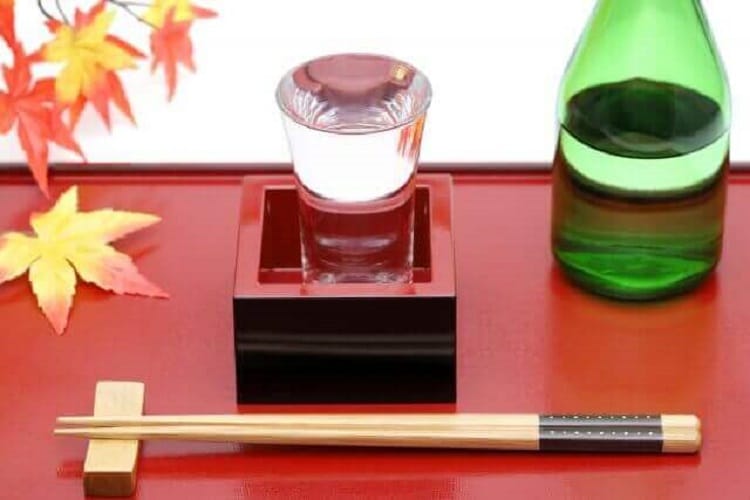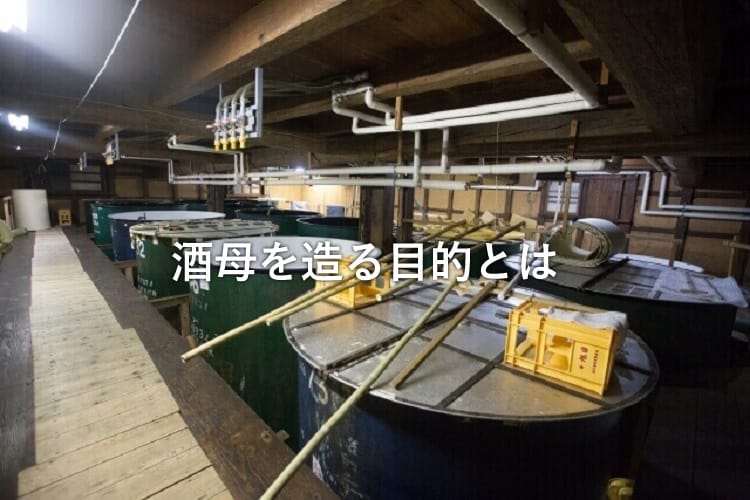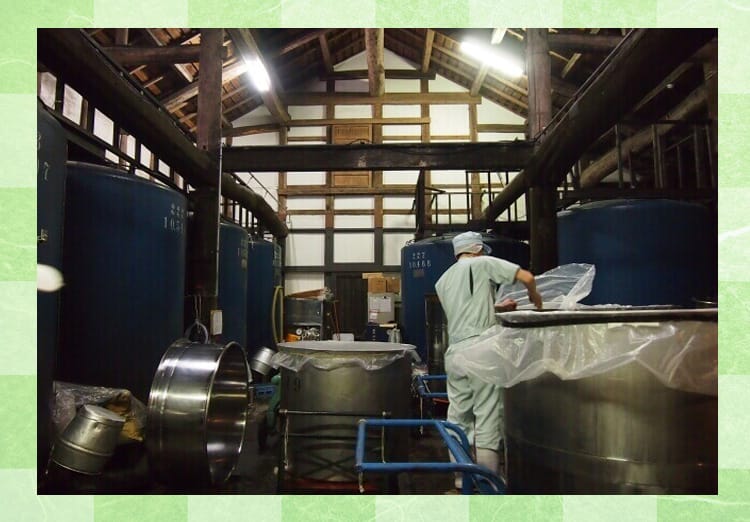
Once the candy is finished, we will move on to the process of “making sake mothers”. Just like reading a liquor mother,Existence that can be said to be a “mom of alcohol”is. It is also called “酛” (original).
This is a very important process because the framework of the taste of sake is generally decided at this stage.
What is the purpose of making a sake mother?

So what exactly is this “sake mother”?
Speaking more specifically,“Purely cultured in large quantities of excellent yeast for fermenting sake”is. To prevent the breeding of wild yeasts and bacteria that interfere with sake brewing,It is characterized by containing a large amount of lactic acid..
Yeast is a kind of microorganisms, like koji molds.Yeast breaks down the sugars changed from starch contained in rice and produces alcoholIt works. In other words, sake cannot be made without yeast.
In sake brewing, it is necessary to ferment a huge amount of rice. In order to do so, it is essential to have tens of billions of billions of astronomical yeast.
In preparation for this, it is necessary to build a liquor made by culturing a large amount of selected yeast in a small amount of straw. By the way, in general, the number of yeasts present in the 1 gram mother isOver 2 billionIt is said that.
Sake brewing is not limited to brewing mothers, but is always exposed to the risk of invasion of wild yeasts and germs because the tank is not sealed with a lid.
However, the presence of these microorganisms is an obstacle for yeast to perform as expected. This is because there is a high risk of losing the target taste and aroma. So what you need isLactic acidIs the existence of
Common microorganisms have the property of being vulnerable to acidity. On the other hand, yeast is weak among microorganisms, and it is deceived when it is with other microorganisms, but it has the advantage of being able to live even in an acidic environment.
In the liquor mother who became acidic with the power of lactic acid, the extra microorganisms will die one after another.. After that, yeast is added and it continues to divide and grow only in the spring of our world.
There are 2 types of how to make a sake mother.

Sake brewing begins with water, rice cake, and steamed rice in a sake mother tank. Liquor tanks generally have a capacity of about 200 kilograms.
As a method of making a sake mother,"Ginger-based liquor"と"Fast brewer"There are two. These fundamental differences lie in the way you get the lactic acid needed to make your liquor acidic.
FormerGinger-based liquor takes in the natural lactic acid bacteria that live in the brewery and acquires the lactic acid produced by the lactic acid bacteriaIt is built in the way.
It is a traditional method that has been used since ancient times. Until the end of the Meiji era, this method was used exclusively for making sake mothers.
The latter quick-brewed liquor mother does not rely on natural lactic acid bacteria.In the first stage of sake brewing, liquid lactic acid called brewing lactic acid is added to the tank in addition to water, koji, and steamed rice.It is a way.
Lactic acid is added in an amount that makes the concentration in the liquor mother about 0.5%.Compared to ginger-based liquor mothers, the tank can be acidified quickly and can be built in a short period of time.So it is called “Hayaki-kei” sake mother.
This method was developed at the National Brewing Laboratory in 1910. Due to its excellent cost, nearly 43% of the current Japanese sake is made with this quick-brewed sake mother.
By the way, the words are similar, but lactic acid bacteria and lactic acid are completely different types.Lactic acid bacteria are microorganisms, that is, living beings, whereas lactic acid is a substance.is. Please note that there are a lot of people who get confused.
Sake Mother 1-Ginger Sake Mother
Ginger-based liquor motherA process that requires more labor, cost, and time than a quick-brewed liquoris. In general, quick brewers are completed in about 2 weeks, whereas ginger-based brewersAbout 4 weeksTakes days.
In addition, since various microorganisms are involved compared to fast brewing sake mothers,A high level of technique is required to achieve the desired quality of sake.. For this reason, there are not many sake breweries that are built.
However, compared to fast-brewed sake mothers, Japanese sake made with ginger-based sake mothersStrong and dark flavor and depth of taste.
By using natural lactic acid bacteria, the content of lactic acid increases, so the acidity is high and the body is rich and you can feel the depth. It is also characterized by increased taste when mochi is used. Therefore, the goodness of ginger-based liquor mothers has been reviewed in recent years, and the number of sake breweries to be restored is increasing.
-A specific production method for ginger-based liquors-
The ginger-based liquor is divided into two parts depending on the manufacturing process."Ginger"と"Mountain Ruins"is. I will introduce how to make each of them.
① Ginger
First, when making "ginger"Divide the steamed rice, rice cake and water into a rice cake with a wide mouth called “half-cut rice cake” and a shallow bottom.. Mix it all with your hands. When steamed rice absorbs water well, mix with a wooden spatula.
after that,Using a stick called `` Kai '', the steamed rice that has swollen with water and the rice cake are crushed to create an environment where lactic acid bacteria are likely to occur.. This crushing work"Wholesale" (Yamaoroshi)Is called. It is also called “Tatsuri”.
“Wholesale” is usually performed by a group of 2 people. It is a steady work that is repeated several times and requires perseverance.
The crushed rice is thrown into the liquor tank. After being cooled for several days, the temperature is gradually raised this time.
When warmed, saccharification progresses due to the action of cocoons, and lactic acid bacteria also work actively.. The state at this time is like yogurt and tastes sweet and sour.
Most of the time I started making sake mothersAdd yeast after about 2 weeksTo do. In order to promote the growth of the yeast, the temperature is adjusted by stirring the liquor mother and warming or cooling it as necessary. It is finally completed in about 4 weeks.
By the way, a tool called “warm barrel” is used to control the temperature. It may be close to the image of a hot water bottle.
If you want to warm your liquor, put hot water in it, and if you want to cool it, put water in, plug it, and put it in the tank. Warm air barrels can be operated in various ways, such as turning in a tank or sinking.
By the way, warm-air barrels used to be wooden, but now it is more common to use metal such as aluminum or stainless steel.
② Mountain ruins
Even if you have heard the word “Yamazuru” itself, it seems that there are not many people who know the meaning properly.
Abandonment is abandoned and a manufacturing method that has come to be called abandoned.is. The brewer's mother is called the “Yama ruins”.
As mentioned earlier, wholesale is a labor-intensive work and places a heavy burden on the builder. Therefore, the National Brewing Laboratory established in the Meiji period repeated various verifications.
As a result,Even if you do not go through a hard process like wholesale, you can make something that is comparable to gingerIt turned out that.
Along with modernization, scientific approaches were introduced in various fields, but sake brewing was no exception.
The method for producing the mountain ruins is to first put water and straw into the liquor tank and dissolve the straw enzymes in the water. this"Water tank"Call it. After that, steamed rice is put into the finished syrup.
In other words,By changing the order in which the ingredients are introduced, you can make delicious sake without having to carry out a wholesale like ginger making.That is why many breweries have shifted to this method.
-What is the difference in taste between ginger and mountain ruins? ~
Regarding the influence of the difference in production method between ginger and mountain ruins on the difference in taste,Scientifically unclear and various views.
But by doing wholesale,The environment in which microorganisms are active changesThat is true.
For this reason, the opinion that ginger is clear and crisp and finishes well, and those who are abandoned are often felt from beginning to end and tend to have a long finish.
That said, the way you taste is different from person to person. Also, even if you say ginger and mountain ruins, 1 books differ depending on the brewery and brand.
Please compare the drinks, find the difference in taste with your own sense, and have fun.
Sake Mother 2-Fast Brewery Sake Mother
In the quick brewing liquor, the lactic acid for brewing is added at the first stage of brewing so that the tank can quickly reach the required acid level..
Therefore, it is possible to avoid the risk that germs will propagate and fermentation will start early due to wild yeast.You can make a sake mother safelyThere is a big merit that.
In general, sake made with fast-brewed sake mothers tends to be light, gentle and soft.
-A specific production method for ginger-based liquors-
There are various ways to make a quick-brewed liquor depending on the manufacturing process. I will introduce how to make each of them.
① Ordinary fast sake brewer
The most orthodox among the fast brewers is the “ordinary fast brewer”.
First of all, water, rice cake, lactic acid for brewing, and yeast are put into a tank for sake mothers to make rice cake, and then steamed rice is added. When steamed rice becomes soft, stir the liquor mother and adjust the temperature up or down according to the situation to promote yeast growth.
after that,Immediately after preparation, the mother who was about 20 ℃ is placed in a low temperature of 10 ℃ or less for about 1-2 days.. Through this process,A training period of about 2 weeksIt ’s done.
② Medium-temperature fast brewing mother
The “medium-tempered sake brewer” will be completed faster than the ordinary fast brewer. The period required for training isAbout a week.
The difference from ordinary quick brewers is that"Whether to lower the temperature"That's the point.
As I introduced earlier, in the manufacturing method of quick brewing brewers, the temperature of brewers immediately after being charged is about 20 ° C. However, in this medium temperature brewing mother, without lowering the temperature after preparation,It is characterized by keeping heat at 20 ℃.
Although it is not as common as ordinary fast brewing mothers, this method may be used depending on the weather at the time of preparation and the target quality of the sake.
③ High-temperature saccharified mother
Next to medium temperature is high temperature. this"High-temperature saccharified liquor" is a technique developed in Hiroshima Prefecture around 1940 (Showa 15).
The main feature of this method isHigh temperature of water used for preparationis. Its temperature isAbout 55 ℃About. It's hot water rather than water.
By keeping this high temperature,Not only does steamed rice easily dissolve and saccharify, but it can also sterilize unwanted microorganisms such as bacteria..
After that, the temperature is rapidly lowered to about 40 ℃, and lactic acid is added first. It is then cooled to about 25 ° C, and yeast is added to culture.
It takes about the same number of days to completeAbout 1 weekWill be completed.
There are many breweries that use this high-temperature saccharified liquor in southern Japan, such as the Kyushu region, where the climate is warm.
④ Ultra Seven Sake
“Is there really a joke-like name?” Is the impression most people have when they first hear it.
It seems that it was named like this because it was made using a sake-making machine named “Ultra Seven”.
After saccharification at a temperature of about 55 ° C, the product is made based on a high-temperature saccharified liquor with a rapid decrease in temperature and addition of lactic acid and yeast.The law.
How much time did it take to train2 days! So you'll instantly “transform!”
As sake made using this Ultra Seven Sake Mother,"Natural Town Seven"There is something called. This is a sake produced by a brewery called Oki Shiroyoshi Main Store (Yabuki-cho, Nishishirakawa-gun, Fukushima Prefecture).
As an aside, there is also sake born in collaboration with "Ultra Seven". that name as well,"Holiday Junmai Daiginjo A MAN of ULTRA".
The first broadcast date of “Ultra Seven”, which celebrated 2017 anniversary in 50, is 1967 month 42 day in 10 (Showa 1). Although it is not well known by non-sake fans, 10 month 1 day is “Sake Day”.
The name of sake is “酉”, but this “酉” is made up of hieroglyphs representing sake. And in the 12th branch, “酉” is the 10-th, that is, 10 month, and it is said that sake brewery is also starting, so 10 month 1 day has become “Sake Day”.
“Celebration Junmai Daiginjo A MAN of ULTRA” was sold on 2017 month 10 month of 1 to commemorate this coincidence. It was built by Yamamoto Honke, a long-established sake brewery with a history of more than 300 years (Fushimi-ku, Kyoto, Kyoto).
Pursuant to the “50 Anniversary” of the start of the broadcast, this is a Junmai Daiginjo sake that has refined the sake “Iwaii” to “50%”. "Holiday" is rice from Kyoto Prefecture, and has a unique taste. The name feels congratulations and is perfect for this collaboration.
In addition to those listed here,"Dilute sake mother" "High-temperature short-term quick brewing mother"Such methods are also being developed.
There are other methods of making a unique sake mother

① Bodhi
Bodhimoto is a production method that has an older history than ginger. It was already established during the Muromachi period.
There are also passages that describe this bodhi in the “Sake no Nikki” and “Tamonin Nikki” written during the Muromachi period.
The great feature of Bodhi is thatUse of “raw rice” in the manufacturing processis mentioned.
As a concrete way of making,First, cook about 10% of raw rice (this is called "Oita"), put this rice in a cotton bag, and put it in a container containing the remaining 90% of raw rice and water. , Move up and down. Then, the lactic acid bacteria start to breed with the power of the ingredients that have melted away from the main body.
The water gradually becomes acidic due to the action of the lactic acid bacteria. This state of water is called “boiled water”. The soy water produced in this way is used as water for the sake mother.
In terms of incorporating and growing natural lactic acid bacteria, the method that became the prototype of ginger-based preparationYou can say.
The reason for this nameDue to the fact that it was built at Bodhizan Shogyoji Temple in Nara City, Nara PrefectureTo do. It is called “Bodaisen”, and it was the most highly appreciated among many priests.
After that, this manufacturing method declined, and production was discontinued for a long time, but in 1996 (Heisei 8), a project to revive the bodhi fountain to the present day "Sake Brewery Study Group by Nara Prefecture Bodhi" was launched It was The main members are Bodenzan Shogyoji Temple, which originated from Bodhi Izumi, volunteers from a brewery in Nara Prefecture, and the Nara Industrial Technology Center.
I repeated trial and error in a steady manner, referring to the documents and materials such as the “Mikomachi Diary” and “Tamonin Diary” from the Muromachi period.
As a result, the manufacturing mechanism was elucidated and this project was a success. In 2 (Heisei 1998) just 10 years after the start, we were able to revive for the first time in several hundred years.Bodhi sakeAs a product, it attracted great attention from all over the country.
After that, Shoryoji was issued a liquor manufacturing license and began making the first sake mother in 1999 in 11.
Since then, every year in the year of 1, sake mothers are brewed on the precincts and prayed for brewing. The liquor mother charged hereA sake brewery who is a member of the “Sake Sake Study Group by Nara Prefecture Bodhi” is taken home and used for sake brewing..
At the festival venue, there are tasting and sales of sake brewed in Bodhi and the behavior of Bodhi Soup. If you are interested, please come and visit us.
② Minamata
“Mizumoto” is an evolution of Bodhi. You can see a description of this production method in the document “Domon Shuzo” written in the Edo period.
mainly,Manufacturing method suitable for sake brewing in warm seasonIt has been with.
Miyoshino brewing (Yoshino-cho, Yoshino-gun, Nara) is made as a famous sake that has been brewed with Minamata."Hanamoe"There is a product called.
I have drunk it once, but the scent of lactic acid reminiscent of yogurt and cheese and the strong acidity were really impressive.
